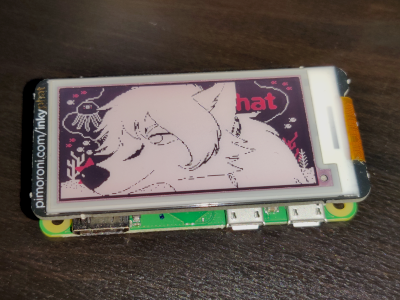Board
Not Bored
What would you do with a tiny computer? More specifically, what would you do with one that had an eInk display attached? What could you do with such a pairing that you might use every day?
 .
.
When it comes to personal projects, inspiration is cheap. It may not come easily but implementation can prove so much more expensive. Finishing a personal project takes an even greater concentration of force. If you want to complete that personal project that’s been rolling around your head all this time, you need creative constraints.
To illustrate, let’s imagine a project that combines a Raspberry Pi with the tiny InkyPHat eInk display. Then we add on other constraints until we have something achievable within a weekend. For example:
- Will you use it every day?
- Passive displays of the weather and temperature are a good example, as that’s something typically checked before leaving the house.
- Perhaps a nightstand clock you can read after sunrise but which lacks LEDs that would otherwise disrupt your sleep.
- Or a rotating set of favorite compliments and positive feedback you’ve received for others, giving you a little emotional boost at the start of each day.
- Can you power it with a battery? If not, how little power can you pull?
- The more flexible your power requirements, the more places you can install the project. If you can avoid an outlet then you could mount the device most anywhere on most any wall, ideally at eye level.
- How few other components can you use? Fewer parts mean fewer possible hardware failures, less assembly, and fewer decisions about what to include in the first place.
- The Raspberry Pi Zero W provides Wifi and Bluetooth built in. That board and the InkyPhat display alone (plus a charging cable) can suffice for many different projects.
- How quickly can you do it?
- A weekend is best, per the above recommendation by Zack Freedman. Longer than that and you run the risk of life and work killing your momentum.
- What’s stopping you? Serious question:
- Which specific parts are you missing? Which tools?
- Have you assembled everything into one place? (Mise en place applies outside of the kitchen.)
- Have you gone through the tutorial for whichever programming language and platform you will use? The more you can prep before the big project assembly event the better, but let your project completion deadline help you decide on what you must learn versus what you would like to learn. Study ahead of time but execute over the weekend.
Most importantly, have fun. Big failures can kill your interest in a hobby, but small and sustainable wins grow into bigger successes over time. So, what do you plan to hack out next? I can’t wait to see it.